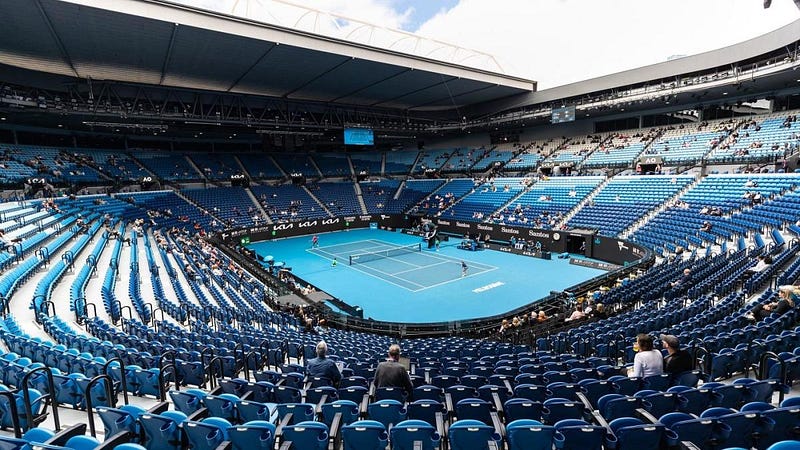
The famous blue tennis court of the Australian Open. Photo courtesy of CBS Sports.
“Owen, are you falling asleep on me?” My professor peered at me curiously as I leaned semiconsciously on my hand.
“Uh, yeah, sorry,” I answered. I wish I could say I was being sarcastic, but I was just too exhausted to formulate a decent answer. The 2021 Australian Open was raging, and I had spent the last few nights staying up until ungodly hours or setting my alarm for 3:00 a.m. to watch tennis.
Every year, I get more invested in tennis, and I try to push my limits farther when it comes to the Australian Open. Last year, I overextended myself in the middle of the tournament and ended up too wiped out to write anything about it. When I watched the Australian Open for the first time in 2017, I only woke up to watch the finals. Now, missing even the first round hurts.
As a rule, I usually avoid naps, since upon waking up from them, my mouth tends to taste even worse than it does after that first bite of quasi-raw Commons chicken. However, this year I have started taking long naps to bank hours of sleep so I can stay up well into the early morning. On Jan. 18, the Australian Open had a great lineup of third-round matches. I wanted to watch several of them, so I stayed up from 10:00 p.m. to 6:00 a.m. I had no sleep that night. After struggling through my class the next day, I slept for 14 of the next 19 hours. On Jan. 24, I did another all-nighter to watch a few quarterfinals.
The Australian Open is more than worth the lack of sleep. It is a magical two weeks: seven rounds, 128 players in the men’s and women’s singles draws. Since it is at the start of the year, players are eager to set the tone for a new season and are energized after the offseason. As such, most are willing to play exhausting matches in Melbourne’s relentless heat. Relentless might be understating it — temperatures at the Australian Open frequently soar above 100 degrees Fahrenheit. In 2009, my family and I took a trip to Melbourne while the Australian Open was happening. Tragically, I was not a tennis fan yet, and did not watch it on TV with my parents. Every day we were there, it was at least 105 °F. One day was 117 °F. I remember feeling fatigued seconds after stepping outside.
On Jan. 23, Simona Halep and Alizé Cornet played a torturous fourth-round match in unforgiving conditions. After an hour — not considered a long time to be on a tennis court — Halep was hunching over after every single point. One point was so brutal that Halep took a momentary break, hands on knees, while the ball was still in play. She ended up winning the point anyway. “It’s inhuman,” Cornet said when reminded by the umpire that she could only take 25 seconds between points. Cornet, who was winning the match at this stage, begged the chair umpire to close the roof of the stadium to create cooler conditions. They denied her request. Each time a player had to run more than a few steps at once felt like a wrecking-ball-sized blow to their midsection.
Cornet eventually won the match. She has been playing professionally for over a decade and a half, but had never advanced as far as the quarterfinals at one of the four majors. When she built a lead in the first half of the match and Halep came back to tie it, more fourth-round misery seemed at hand for Cornet. Yet she refused to be blocked again by the fourth round and ended up outlasting Halep.
After the match, Jelena Dokic interviewed Cornet. At the Australian Open in 2009, Cornet was slated to play Dokic in the quarterfinals, but lost in her fourth round match despite being a point away from winning multiple times. Cornet and Dokic hugged. Dokic congratulated Cornet on making her first major quarterfinal. Cornet said how happy she was.
Dokic congratulated Cornet again, signaling the end of the interview. “Wait,” Cornet said, then commended Dokic for moving on with her life. Dokic had been physically and mentally abused repeatedly by her father from the tender age of six until deep into her playing career. The trauma almost drove her to commit suicide. “You were an amazing player, and now you are an amazing commentator,” Cornet told Dokic. She urged the crowd to applaud. They did. Cornet had been crying tears of joy at the start of the interview, then Dokic did the same as it concluded. It was a lovely moment.
For two weeks, the Australian Open produces tennis matches imbued with the stories of players’ careers. Aging veterans make final grabs at glory. Young upstarts try to prove themselves. The athletic feats are incredible. Players slide on the cement court to change direction after sprinting for a ball, which you kind of just have to see in action to understand or believe. The tournament is like an epic novel, year after year. It all plays out on blue tennis courts, for which one adjective is not sufficient description. The courts are deeply, vibrantly blue. They are blue the way David Wippman is bald; it is their all-encompassing visual characteristic. They are beautiful.
The Australian Open is at pretty much the worst time possible (it ends on Jan. 30), but if you find yourself awake at three in the morning in the next few days, fire up ESPN and give it a try. You will probably see something special.